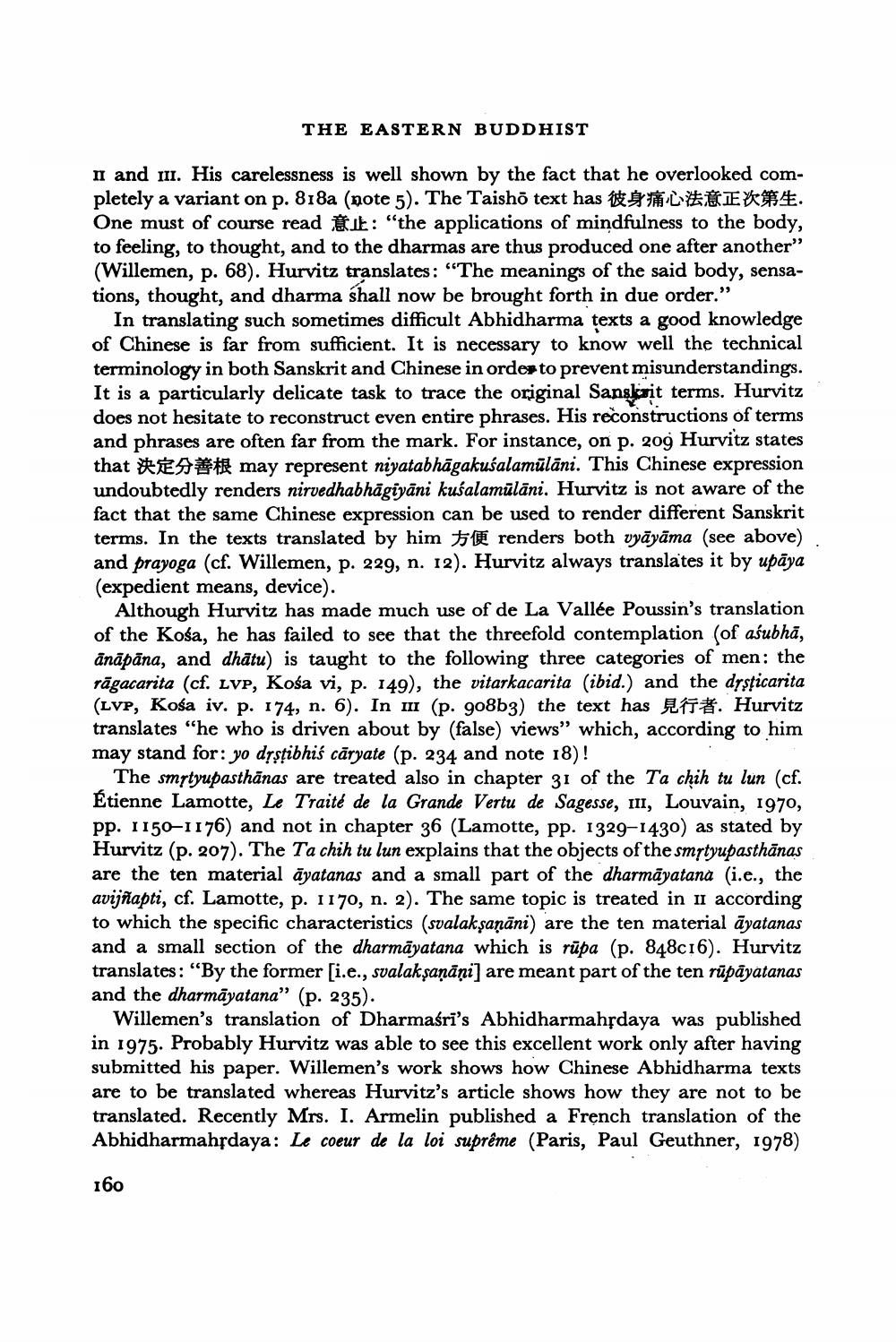________________
THE EASTERN BUDDHIST
II and III. His carelessness is well shown by the fact that he overlooked completely a variant on p. 818a (note 5). The Taishō text has EKSE. One must of course read : "the applications of mindfulness to the body, to feeling, to thought, and to the dharmas are thus produced one after another" (Willemen, p. 68). Hurvitz translates: "The meanings of the said body, sensations, thought, and dharma shall now be brought forth in due order."
In translating such sometimes difficult Abhidharma texts a good knowledge of Chinese is far from sufficient. It is necessary to know well the technical terminology in both Sanskrit and Chinese in order to prevent misunderstandings. It is a particularly delicate task to trace the original Sanskrit terms. Hurvitz does not hesitate to reconstruct even entire phrases. His reconstructions of terms and phrases are often far from the mark. For instance, on p. 209 Hurvitz states that may represent niyatabhāgakusalamulāni. This Chinese expression undoubtedly renders nirvedhabhagiyāni kuśalamulāni. Hurvitz is not aware of the fact that the same Chinese expression can be used to render different Sanskrit terms. In the texts translated by him renders both vyāyāma (see above) and prayoga (cf. Willemen, p. 229, n. 12). Hurvitz always translates it by upaya (expedient means, device).
Although Hurvitz has made much use of de La Vallée Poussin's translation of the Kosa, he has failed to see that the threefold contemplation (of aśubha, ānāpāna, and dhātu) is taught to the following three categories of men: the rāgacarita (cf. LVP, Kośa vi, p. 149), the vitarkacarita (ibid.) and the drsticarita (LVP, Kosa iv. p. 174, n. 6). In ш (p. 908b3) the text has T. Hurvitz translates "he who is driven about by (false) views" which, according to him may stand for: yo dṛṣṭibhiś cāryate (p. 234 and note 18)!
The smṛtyupasthānas are treated also in chapter 31 of the Ta chih tu lun (cf. Étienne Lamotte, Le Traité de la Grande Vertu de Sagesse, III, Louvain, 1970, pp. 1150-1176) and not in chapter 36 (Lamotte, pp. 1329-1430) as stated by Hurvitz (p. 207). The Ta chih tu lun explains that the objects of the smrtyupasthanas are the ten material ayatanas and a small part of the dharmayatana (i.e., the avijñapti, cf. Lamotte, p. 1170, n. 2). The same topic is treated in II according to which the specific characteristics (svalakṣaṇāni) are the ten material āyatanas and a small section of the dharmāyatana which is rūpa (p. 848c16). Hurvitz translates: "By the former [i.e., svalakṣaṇāņi] are meant part of the ten rūpāyatanas and the dharmayatana" (p. 235).
Willemen's translation of Dharmasri's Abhidharmahrdaya was published in 1975. Probably Hurvitz was able to see this excellent work only after having submitted his paper. Willemen's work shows how Chinese Abhidharma texts are to be translated whereas Hurvitz's article shows how they are not to be translated. Recently Mrs. I. Armelin published a French translation of the Abhidharmahrdaya: Le coeur de la loi suprême (Paris, Paul Geuthner, 1978)
160




